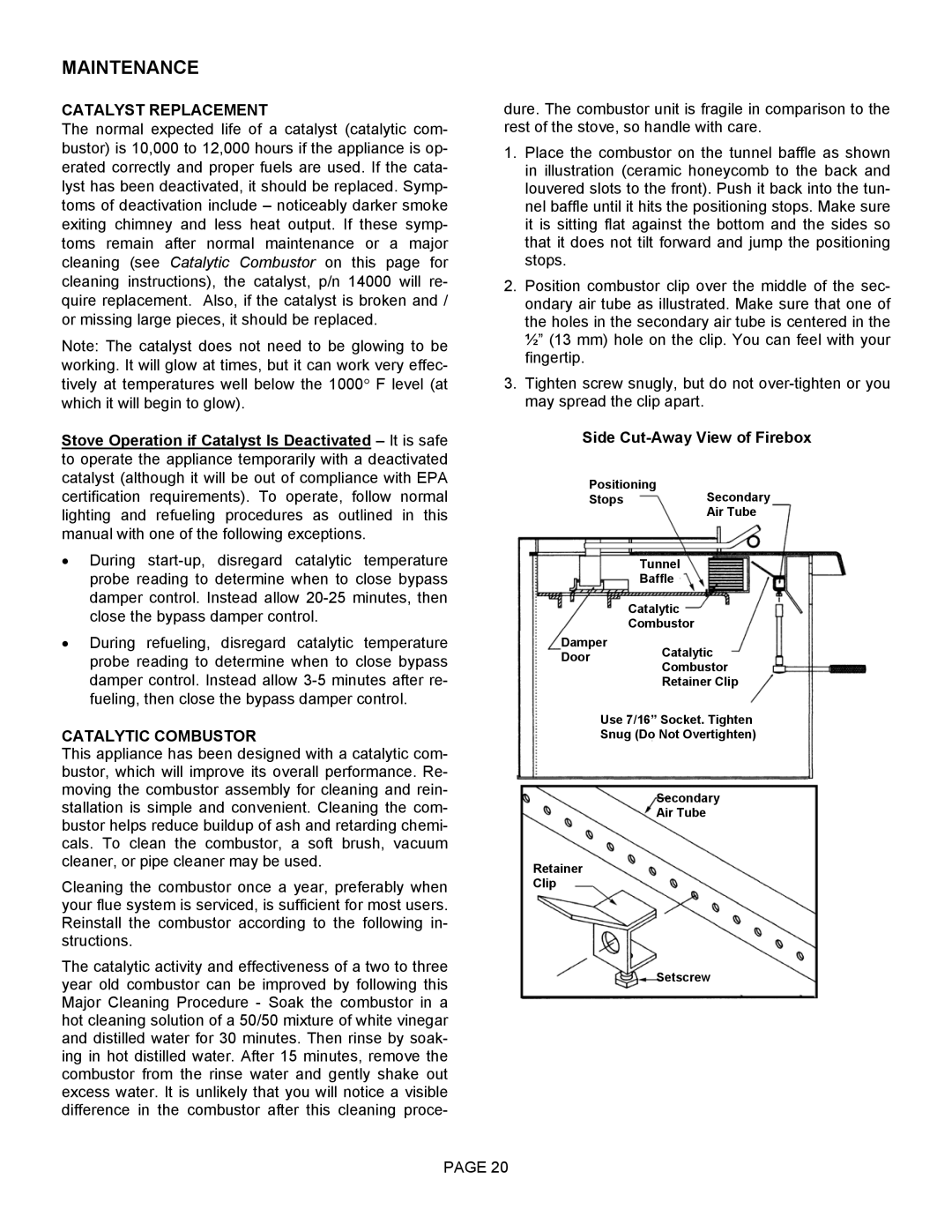
MAINTENANCE
CATALYST REPLACEMENT
The normal expected life of a catalyst (catalytic com- bustor) is 10,000 to 12,000 hours if the appliance is op- erated correctly and proper fuels are used. If the cata- lyst has been deactivated, it should be replaced. Symp- toms of deactivation include – noticeably darker smoke exiting chimney and less heat output. If these symp- toms remain after normal maintenance or a major cleaning (see Catalytic Combustor on this page for cleaning instructions), the catalyst, p/n 14000 will re- quire replacement. Also, if the catalyst is broken and / or missing large pieces, it should be replaced.
Note: The catalyst does not need to be glowing to be working. It will glow at times, but it can work very effec- tively at temperatures well below the 1000° F level (at which it will begin to glow).
Stove Operation if Catalyst Is Deactivated – It is safe to operate the appliance temporarily with a deactivated catalyst (although it will be out of compliance with EPA certification requirements). To operate, follow normal lighting and refueling procedures as outlined in this manual with one of the following exceptions.
•During
•During refueling, disregard catalytic temperature probe reading to determine when to close bypass damper control. Instead allow
CATALYTIC COMBUSTOR
This appliance has been designed with a catalytic com- bustor, which will improve its overall performance. Re- moving the combustor assembly for cleaning and rein- stallation is simple and convenient. Cleaning the com- bustor helps reduce buildup of ash and retarding chemi- cals. To clean the combustor, a soft brush, vacuum cleaner, or pipe cleaner may be used.
Cleaning the combustor once a year, preferably when your flue system is serviced, is sufficient for most users. Reinstall the combustor according to the following in- structions.
The catalytic activity and effectiveness of a two to three year old combustor can be improved by following this Major Cleaning Procedure - Soak the combustor in a hot cleaning solution of a 50/50 mixture of white vinegar and distilled water for 30 minutes. Then rinse by soak- ing in hot distilled water. After 15 minutes, remove the combustor from the rinse water and gently shake out excess water. It is unlikely that you will notice a visible difference in the combustor after this cleaning proce-
dure. The combustor unit is fragile in comparison to the rest of the stove, so handle with care.
1.Place the combustor on the tunnel baffle as shown in illustration (ceramic honeycomb to the back and louvered slots to the front). Push it back into the tun- nel baffle until it hits the positioning stops. Make sure it is sitting flat against the bottom and the sides so that it does not tilt forward and jump the positioning stops.
2.Position combustor clip over the middle of the sec- ondary air tube as illustrated. Make sure that one of the holes in the secondary air tube is centered in the ½” (13 mm) hole on the clip. You can feel with your fingertip.
3.Tighten screw snugly, but do not
Side Cut-Away View of Firebox
Positioning
StopsSecondary
Air Tube
Tunnel
Baffle
Catalytic
Combustor
Damper
DoorCatalytic
Combustor
Retainer Clip
Use 7/16” Socket. Tighten
Snug (Do Not Overtighten)
Secondary
Air Tube
Retainer
Clip
Setscrew
PAGE 20
